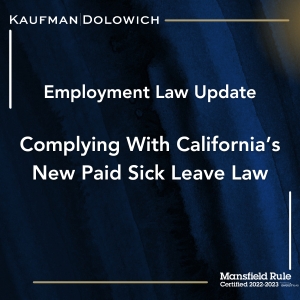Complying With California’s New Paid Sick Leave Law, by Allyson Thompson, Partner, Kaufman Dolowich LLP, 1-29-2024
The New Year brought with it significant changes to California’s paid sick leave law. As such, employers who have not yet updated relevant policies and handbooks must ensure they are in compliance with Senate Bill 616, which increases mandatory paid sick leave (PSL) from three days/24 hours to five days/40 hours annually. The new legislation, which went into effect January 1, 2024, also increases the accrual and carryover amounts.
Who is Eligible?
Employees who work at least 30 days for the same employer within a year in California, including part-time, per diem, in-home supportive services (IHSS) providers, and temporary employees, are covered by this law with some narrow exceptions, according to a new FAQ from California’s Department of Industrial Relations (“DIR”).
Exemptions
Employees exempt from the paid sick leave law include:
- Individuals employed by an air carrier as a flight deck or cabin crew member, if they receive compensated time off at least equivalent to the requirements of the paid sick leave law.
- Retired annuitants working for governmental entities.
- Employees of railroads.
- Employees in the construction industry covered by a collective bargaining agreement (CBA) with specified provisions.
Allowable Uses
Employees can use PSL to:
- Recover from physical/mental illness or injury;
- To seek medical diagnosis, treatment, or preventative care; and,
- To care for a family member who is ill or needs medical diagnosis, treatment, or preventative care.
Key Provisions
As outlined in the California DIR’s FAQ, among key provisions:
Employers can still choose to have an “accrual” policy or an “up front” policy. Employers may adopt or keep other types of accrual schedules, other than providing one hour per every 30 hours worked, as long as the schedule results in an employee having no less than 24 hours of accrued sick leave or paid time off by the 120th calendar day of employment and no less than 40 hours of accrued sick leave or paid time off by the 200th calendar day of employment.
Although employees may accrue more than five days of paid sick leave under the one hour for every 30 hours worked accrual method (or under an alternative accrual standard), the law allows employers to limit an employee’s use of paid sick leave to 40 hours or five days during a year, according to DIR. The law also allows an employer to limit an employee’s total accrued paid sick leave to no more than 80 hours or ten days. Prior to January 1, 2024, an employer could limit an employee’s use to 24 hours or three days during a year and an employee’s accrual to no more than 48 hours or six days.
An up-front policy makes the full amount of sick leave for the year available immediately at the beginning of a year-long period, except for initial hires where 3 days or 24 hours must be available for use by the 120th calendar day of employment and 5 days or 40 hours must be available for use by the 200th calendar day of employment, according to DIR. The employer must provide at least 40 hours or five days of paid sick leave per year and the full amount of this leave must be available for the employee’s use from the beginning of each year of employment, calendar year, or 12-month period.
Some plans existing prior to January 1, 2015 are “grandfathered” in allowing employers to maintain those policies and be deemed in compliance if they meet certain criteria. Additionally, SB 616 extends certain anti-retaliation provisions and requirements of the sick leave law to employees covered by CBAs that otherwise wouldn’t be covered.Further, SB 616 also states that certain of the law’s provisions “shall preempt any local ordinance to the contrary.” Employers should be cognizant of both local and California laws.
Steps for Employers
The law is in full effect and to maintain compliance employers should consider:
- Updating or revising existing paid sick leave policies to comply with the new law;
- Updating handbooks where applicable given this new law and the host of other California laws that have recently passed;
- Training key staff to understand the new law’s requirements;
- Talking to your payroll provider and or update payroll systems to ensure wage statements are adjusted;
- Displaying the updated PSL poster where employees can easily read it; and,
- Using the updated “Notice to Employee” form that reflects the law’s changes.
If you have questions about SB 616, Kaufman Dolowich’s skilled labor and employment attorneys can help with updating policies, practices and procedures to ensure compliance. Author Allyson Thompson is a Partner at Kaufman Dolowich who represents clients in all aspects of employment litigation.











